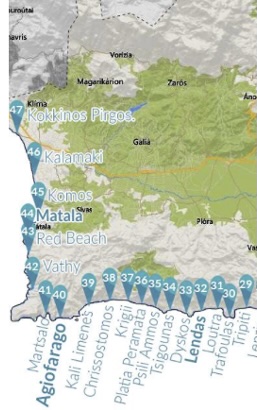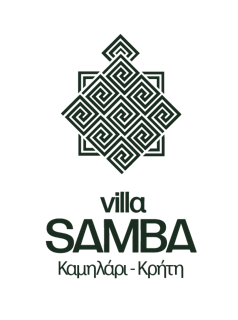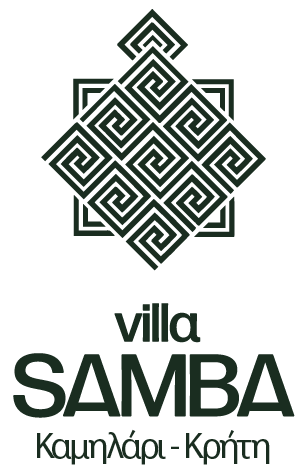Beaches & Coves
a wide choice of places to swim and discover the beauties of the island
Driving along dusty dirt roads through rocky pastures or hiking through canyons, it always ends at a splendid secluded beach for a refreshing swim. The shades of the sea play their colours with the rocks and the sun. Some of the most popular beaches are Agiofarago, while there are still impressive beaches at Vathy, Trafoulas by Lendas, Aspes and Agios Nikitas. Those who prefer to stay close to ‘civilisation’ can swim under the legendary caves of Listis by Keratokambos and the dunes of Komos by Matala. On the north coast, you'll find heavenly beaches with azure waters in the coves of Sarandaris in Hersonissos, Potamos in Malia and Dia Island.

We cannot disclose all beaches so just picked up a selection of those within a radius of 40km from Villa Samba
47.Kokkinos Pirgos (i.e. Red Tower) is located 67 km west of Heraklion and close to the town of Tymbaki. The name is taken from the tower that was there and which was built with reddish soil. The purpose of this tower is still unknown. Kokkinos Pirgos is the seaside village of Timba-ki, which is home to the region’s port and has developed as a tourist destination. In Kokkinos Pirgos you will find numerous hotels, rooms, restaurants and cafés. The climate of the region is warm, which is indicated by the many greenhouses growing fresh vegetables.
Opposite the village, there is a very long sandy beach that begins and stretches for several kilometres south-east to Kommos. This huge beach is home to several sea turtles (Caretta caretta), which nest their eggs here in summer. The turtles and their nests are protected by voluntary organisations. Kokkinos Pirgos beach is open to westerly winds. It begins to the east of the Timbaki military airport fence and runs west to Agia Galini.
46. Kalamaki is a small seaside village located 65 km south-west of Heraklion, between Matala and Kokkinos Pirgos. The beach in front of the village is only a small part (2.5 km) of the vast seafront that stretches along the long Messara Bay.
The beach has light-coloured sand and the sea is a large, smooth rock, which is quite slippery. Large waves that are generally kicked up by north-westerly winds, combined with the rocky seabed, make swimming difficult. Opposite the village, the beach is well organised with umbrellas, sun loungers, tavernas, rooms, lifeguards, playgrounds, water sports, etc., but if you want to keep your distance, you can walk east to Kommos beach, mainly preferred by nudists.
You can also walk north to Afratias or Pahia Ammos beach. The beach has places with rocks. If you’re lucky, in Afratias you may come across a beach party organised by the locals in August. The beach is completely desor-ganised and far from facilities.
45. Kommos (or Komos) beach lies 66km south-west of Heraklion, 2km north of Matala and ends at the coastal village of Kalamaki. It is the largest, southernmost and most isolated beach in Messara Bay. Kommos was once the port of Phaestos, and you can still see the ruins of the town near the beach. You can reach Kommos by car via the road towards Matala, until it is signposted Kommos.
The seafront is exposed to westerly winds, which are the prevailing winds in the region. Care must be taken as the seabed is covered with a layer of rock, not just sand. The protected Caretta caretta turtles nest in the sand of the beach from May to September.
The northern part of Kommos, Potamos or Potamoserma, has been a favourite destination for naturists since the days when hundreds of hippies came to the area. There are only a few tamarisk trees around and no buildings, as Kommos is a protected archaeological area where building is prohibited. Next to the archaeological site, to the south, there is a beach with umbrellas, deckchairs, toilets, showers, a taverna and a lifeguard.
44. Matala is located 68 kilometres south-west of Heraklion, on the boundary between the Messara and Asteroussia mountains. It is one of Crete’s most popular tourist destinations and certainly Heraklion’s most famous beach. It is famous for its rock caves and 70s hippies. It is close to Phaestos, the second largest palace of the Minoan civilisation. Matala was the port of Phaestos, and in Roman times it was the port of Gortyn.
Matala lies at the end of a small valley, which forms a large enclosed bay with a beautiful view of the Paximadia islands. It has a beautiful, long beach 300 m long, with fine gravel and crystal-clear water. The seabed is quite rocky in places and the waves, due to the frequent westerly winds, are very large. There is also a huge cave on the northern part of the beach, from the top of which some people dive into the water. The beach is very well organised, with umbrellas, toilets, showers, lifeguards, first aid, beach volleyball, snack bars, water sports, cruise boats and more. Near Matala, you’ll find plenty of accommodation, entertainment and dining options.
43. The Red Beach is located in Moudia, 68 km south-west of Heraklion and 800 m south of the famous resort of Matala. To get there, you have to walk along a path that starts north of the houses in Matala and crosses the hill to the north of Matala. There are signs pointing the way. At the start of the route, you have to climb some rocks, and in the last few metres you have to descend a steep cliff, but it is not particularly difficult. After a 15-25 minute walk from Matala and passing through a shepherd’s gate (close the gate so as not to let the goats escape!), you will see the magnificent red beach. The view from the hill is the best place to watch the sunset. Alternatively, you can take a boat from Matala harbour.
This secluded beach is truly beautiful, but it is vulnerable to the westerly winds that frequently blow through the region. Its characteristic feature, as the name suggests, is the reddish sand that comes from the rocks in the area. The colours of the sea are blue-green, making for a very beautiful landscape. The Red Beach is not organised, but there is a rudimentary café-shop (which is not always open), where you can get food and drinks. There are also a few parasols, which may already be taken if you come late. So it’s a good idea to bring parasols with you, because the only natural shade is provided by a couple of tamarisk trees next to the canteen.
42. Vathi is a spectacular beach, 79km south-west of Heraklion and 17km from the village of Sivas. Situated close to the southern tip of Crete, Cape Lithino, Vathi is an ideal destination for those seeking ultimate relaxation as it is far from urban centres.
The beach lies at the end of a small gorge, surrounded by long cliffs. The circular loop of the bay protects it from the open sea, making Vathy a natural hideaway. Not surprisingly, it was once a pirate hideout. The beach is well protected and almost always has calm waters.
There are plenty of beautiful natural caves caused by the erosion of white limestone by wind and salt all along the wall of the gorge. Nearby, you’ll see a number of makeshift shelters and primitive houses built by the locals, mainly from the village of Gergeri. Their ancestors spent the winter with their sheep in this more temperate place. Their heirs now spend their summers in this tranquil spot.
There is a small primitive café-shop on the beach, offering food and drink to visitors, who arrive here mainly by boat from Matala. The beach is mainly sand with a few stones. The water is not very deep and the beach is surrounded by several trees (tamarisk), where you can find shade. Nudism is not permitted here, as it is considered offensive to the religious history of the area (due to the Odigitria Monastery).


